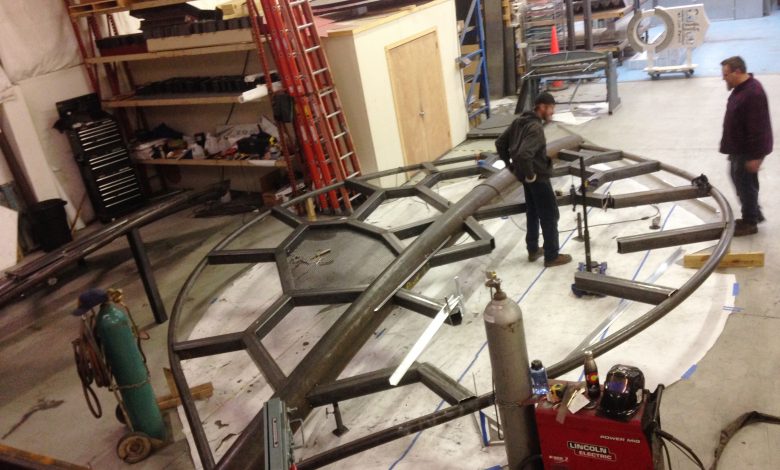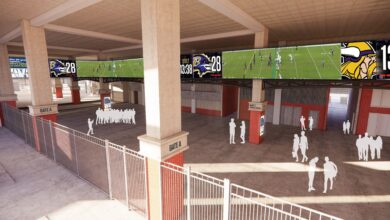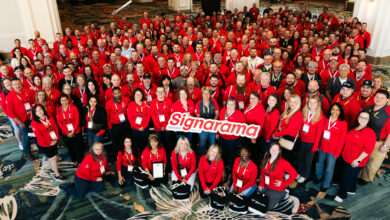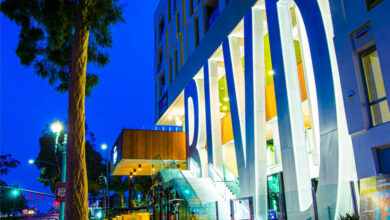On the Job: Adding Art to the Mix
BSC Signs expands beyond electric signs to fabricating large-scale sculptures
An electric sign company in Broomfield, Colorado, wanted bigger jobs and to diversity its product mix, so it jumped at a chance to create large-scale art.
BSC Signs-the BSC refers to Broomfield Sign Co.-moved from 8,000 square feet of space to 21,000 square feet and 21-foot ceilings in 2014 and launched an architectural and lighting division, BSC Custom, growing from a staff of 25 to 38.
“Now that we have a big shop, let’s look at bigger, more interesting projects,” says John Dobie, founder and president of BSC Signs. “It gave us a lot of space, and we started thinking about what else we could build besides signs.”
The space became a useful setting for BSC Custom to fabricate the Littleton Village Outdoor Art Project, an architectural project and leaf canopy sculpture at Central Park in the Littleton Village, a 77-acre planned development in southeast Littleton.
“They wanted to feature a piece that is not only beautiful to look at but functional, providing a shade structure,” Dobie says. “Families can meet up and relax and have a little bit of shade in the summer.”
What the Sculptures Look Like
Staff at BSC Custom envisioned producing a leaf sculpture that incorporates biomimcry by replicating true life with “bold, modern architecture,” as stated in a write-up about the project, “Littleton Village Outdoor Art Project.”
“It mixes nature and manmade together to look like modern architecture with natural elements to it,” Dobie says.
BSC Custom built two leaf elements for the sculpture, each with a central pole and three leaves, and installed a set of five festoon poles that support cables and lanterns. The elements have a dark green, a light green and a yellow leaf rotating off a 24-foot metal stem as if caught by a sudden breeze, providing a whimsical feel to a shade structure in the park, about 10 miles south of Denver. Ground level lighting adds to that feel with a dramatic night effect.
The largest leaf is 27 feet long and 18 feet wide at the broadest points, and the smallest is 16 feet and 14 feet from tip to tip.
“We felt that because architectural projects involve metal fabrication, welding and painting, all the things we do with signage, we felt like we could adapt to a different type of work using the same materials,” Dobie says.
Fabricating the sculpture became “the most complicated job we have ever done,” Dobie says.
BSC Custom fabricated and installed the sculpture, which Norris Design, an architectural design firm in Denver, designed with input from BSC Custom. Norris Design also developed the concept for the park space and amenities.
“It all had to be built to strict engineering standards, so we worked with a structural engineer on how it was all going to fit together and be strong enough to withstand the strong Colorado winds” Dobie says.
The Design Process
The timeframe to make the sculpture from the approved shop drawings to the installation in late spring 2017 took nearly six months.
The designers at BSC Customs created the drawings, or 3D design models, to demonstrate how best to fabricate the sculpture for onsite assembly that addresses the challenges of fabricating the leaves’ complex compound curves. The leaves had to be designed so they could be suspended from a crane and bolted into place. They also had to have attachment points able to withstand 130-mile-per-hour winds, and the center pole had to be securely anchored to the ground.
“They understand and are very capable of doing 3D renderings, working with architectural concepts and bringing them into our designs,” Dobie says. “Bringing them into reality was a relatively easy process for us.”
But the leave structures proved more complicated to design and fabricate than the typical sign, Dobie says.
“Signs take an average of two to four weeks to build versus the nearly six months it took for the sculptures. Signs are often square and relatively easy to build,” Dobie says. “Little Village has multiple compound curves and complicated angles to go with those curves. It’s not like a box. It’s freeform shapes.”
The Fabrication Process
The staff identified steel as the best material to use for the components of the sculpture but found shaping the pipes to be a challenge. The pipes had to be bent to compound curves to the perfect radii, a task that couldn’t be performed simply by using Computer Numerical Controlled equipment. To do the work, BSC subcontracted with a California company that had the right equipment for the job.
Even though the project was designed in 3D, the staff was not able to build any other parts of the sculpture using the CNC equipment because of the complexity of the design. Staff hand-cut the materials for the sculpture with a heavy-duty bandsaw and welded the steel together.
“The fabrication methods were simple. It was the detail that was the hard part, getting the pieces to fit together,” Dobie says. “Once you add all the curves and angles to an object, it makes it 10 times more complicated than a square shape.”
Every part of the sculpture has bends and curves without any straight lines. The center pole of each leaf tapers toward the top, and the leaves’ outer parts have hollowed steel tubing. Inside the leaves, there is additional welded square tubing to represent the veins, giving the internal structure the appearance of a honeycomb, as Dobie described it.
“Once that was done, we had to make paper patterns that fit inside the honeycombs and then using a manual plasma cutter, we cut each multi-sided panel to fit perfectly in each space,” Dobie says, explaining that some of the panels were solid and others were perforated.
Once the panels were fabricated, they were moved to BSC Custom’s back lot to have enough space to sandblast them down to the bare metal for better paint adhesion. The panels were then primed and painted in large paint booths using the Matthews Paint brand of acrylic polyurethane paint in the three different colors selected for the project.
The Installation
Each leaf canopy structure was installed at the park, a project that took two days. The two large leaves for each element of the sculpture had to be constructed in two pieces in order to fit underneath several highway bridges-and then were welded on site by BSC Custom’s certified welders. The smaller leaves could fit on a low-bed trailer in one piece.
Once the pieces were on site, they were too heavy to use BSC Custom’s cranes, so the company hired out a large construction crane company to lift the pieces into place. The two top leaves weighed about 5,700 pounds each, and each structure, including the center poles, weighed about 11,000 pounds.
BSC Custom’s crews bolted the leaves into place. The main structures were bolted to the foundation, and the leaves were bolted to the pole.
“We, one at a time, slid down the leaves and bolted them to match the plates that are part of the trunk,” Dobie says. “The leaves had plates welded to the structure and were matched to the plates on the trunk. … Once it was all bolted together, then we had a little paint touch-up, because it’s pretty hard to move a heavy structure like that without scuffing up the paint.”
Once completed, the sculpture immediately brought people to the park and to the development, Dobie says.
“It’s very pretty to look at and doing its job of attracting people to the development,” Dobie says. “It has become a real talking point in Littleton. Nobody has seen anything like it.”
Conclusion
The sculpture also got noticed by the sign community and received the World Sign Associates’ “Best in Show” award at the annual convention in Seattle in September.
“Although we’re very proud of the project, it had a very steep learning curve. Anything as complicated as this is very difficult to estimate, particularly labor. Without our experienced designers, fabricators and installers, it would have been impossible,” Dobie says. “We learned a lot from this project and are looking forward to our next challenge.”













